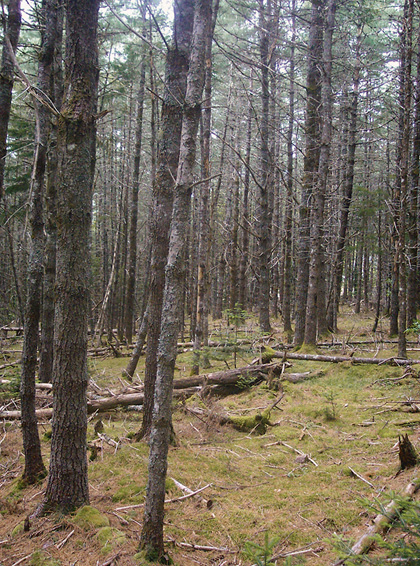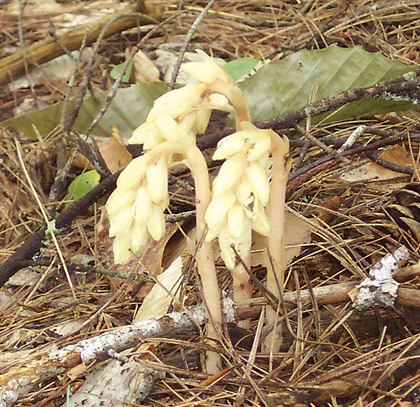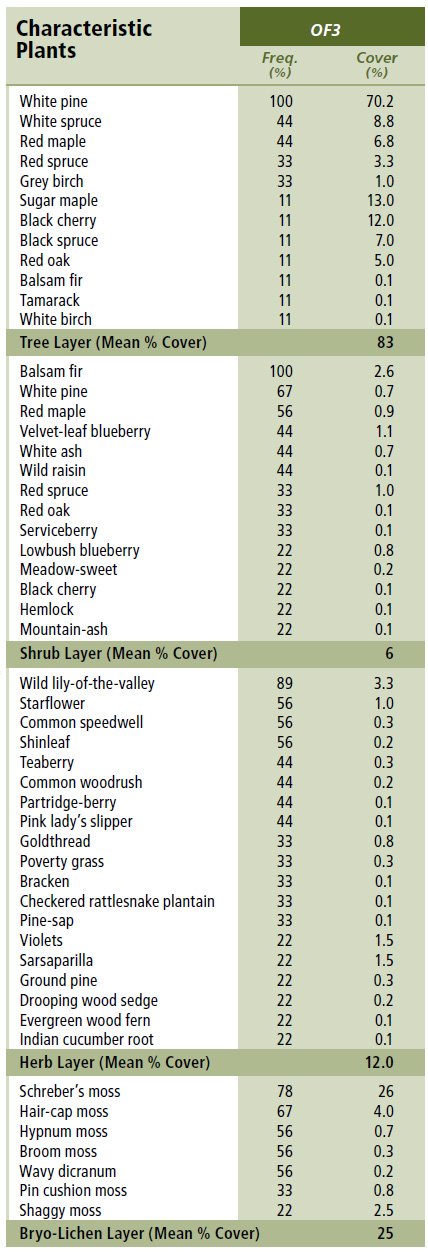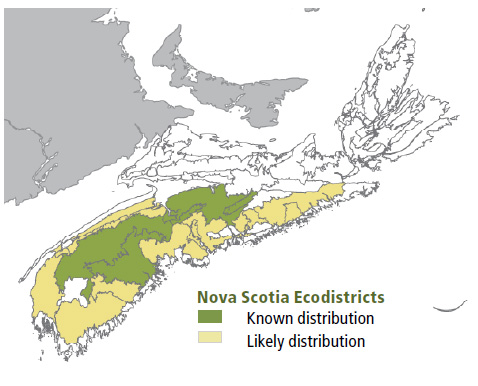
Forest Vegetation types - OF3
OF3 — White pine – Balsam fir / Shinleaf – Pine-sap
Pinus strobus – Abies balsamea / Pyrola elliptica – Monotropa hypopithys
 |
Horne Settlement, Hants County |
Concept: This early to mid-successional Vegetation Type (VT) has abundant white pine in the canopy with only a scattered mix of other species. OF3 stands usually develop full overstory canopies resulting in needle carpet and/or moss dominated forest floors with reduced shrub and herb cover. White pine – Balsam fir / Shinleaf – Pine-sap represents the dominant softwood forest associated with abandoned agricultural lands in western Nova Scotia.
Vegetation: White pine is the dominant overstory tree. Common associates include white spruce, red maple and red spruce. Scattered sugar maple and black cherry can also be found in some stands. The shrub layer is usually poorly developed with balsam fir regeneration providing most of the cover. Herb layer development is also restricted, with typical upland species such as wild lily-of-the-valley, starflower, partridge-berry and goldthread. Sporadic occurrence of hawkweeds, goldenrods, asters and common speedwell reflect past agricultural land-use. Moss cover can be variable and interspersed with needle carpet. Where present, Schreber's moss and hair-cap moss are the main moss species, with shaggy moss also found in some stands.
Environmental Setting: OF3 is mainly associated with fresh to fresh-moist, nutrient medium to rich soils of medium to coarse texture (although finer textures can sometimes be found). This VT is found mainly in western Nova Scotia, often on drumlins. Sites that have been tilled or pastured will have level microtopography and a distinct Ap (plough layer) soil horizon.
Successional Dynamics: OF3 is an even-aged, early to mid-successional VT dominated by white pine. As a long-lived species, white pine will generally maintain its presence in these stands as they develop over time. Usually balsam fir is the first to become prolific in the understory, but eventually other shade-tolerant species (such as red spruce, hemlock, sugar maple and beech) will also appear, especially if suitable seed sources are nearby. Natural disturbance agents include insects and disease (e.g. white pine weevil, white pine blister rust), fire and windthrow. Clearcut harvesting may trigger an earlier successional stage dominated by aspen, white birch and/or red maple). Depending in part on the level of advanced regeneration at time of harvest, OF3 may also succeed to OF4 (Balsam fir –White spruce / Evergreen wood fern – Wood aster) or other VTs dominated by balsam fir, red spruce, white pine or hemlock. On many drumlins, the long and intense history of agricultural land use often masks any signs of original forest composition. However, available evidence suggests that most sites likely supported a climax hemlock-beech mixedwood ecosystem similar to MW3 (Hemlock – Yellow birch / Evergreen wood fern).
Ecological Features: This forest occurs in small patches of abandoned agricultural land, primarily on drumlins in western Nova Scotia. Past cultivation has leveled most pre-disturbance microtopography, while rock walls and piles, old foundations and wells provide additional evidence of agricultural land use. Linear rock piles may provide dwellings for rodents, snakes, and insects like wasps and bees. Other unique aspects include the forest's close proximity to open fields and active farms and the frequent presence of apple and other fruit trees. These features may attract deer, red fox, coyotes, red and flying squirrels, and several birds including ruffed grouse and American kestrel. Although these forests add to landscape structure, they have a simplified ecological make-up, reflected by low tree diversity, structural complexity and deadwood volume.
 |
| Pine-sap |
Distinguishing Features: This white pine dominated softwood forest usually occurs on drumlins in western Nova Scotia. Balsam fir regeneration is common. Level microtopography and a soil profile that shows a plough layer are good site indicators.
| Slope Position: | Middle3 Upper3 Level2 Lower1 Toe1 |
Surface Stoniness: |
(Non - Slightly)6 (Moderately)4 |
Bedrock Outcrop: |
(Non-rocky)10 |
Elevation Range: |
40 - 185m |
Slope Gradient: |
Gentle7 Level2 Steep1 |
Aspect: |
North1 East4 South3 West1 None1 |
Exposure: |
Moderate6 Mod. exposed3 Mod. sheltered1 |
Microtopography: |
Level4 Moderate2 Strongly2 Slightly1 nd1 |
Drainage: |
Well5 Moderately well4 Imperfect1 |
Soil Type: |
ST87 ST2-L1 ST91 ST111 |
Parent Material: |
Glacial till8 nd2 |
Rooting Depth (cm): |
(30-45)6 (>45)3 nd1 |
Duff Thickness (cm): |
(0-5)6 (6-10)3 nd1 |

